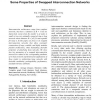Free Online Productivity Tools
i2Speak
i2Symbol
i2OCR
iTex2Img
iWeb2Print
iWeb2Shot
i2Type
iPdf2Split
iPdf2Merge
i2Bopomofo
i2Arabic
i2Style
i2Image
i2PDF
iLatex2Rtf
Sci2ools
CIC
2004
2004
Some Properties of Swapped Interconnection Networks
Interconnection architectures range from complete networks, that have a diameter of D = 1 but are impractical except when the number n of nodes is small, to low-cost, minimally connected ring or loop networks whose diameter D = n/2 is unacceptable for large n. In this paper, our focus is on swapped interconnection networks that allow systematic construction of large, scalable, and highly modular parallel architectures, while maintaining desirable properties of underlying basis networks. We show how key parameters of a swapped interconnection network are related to the corresponding attributes of its basis network and demonstrate applications of these results to synthesizing large networks with desirable modularity, packageability, performance, and fault tolerance attributes. Keywords
| Added | 30 Oct 2010 |
| Updated | 30 Oct 2010 |
| Type | Conference |
| Year | 2004 |
| Where | CIC |
| Authors | Behrooz Parhami |
Comments (0)

